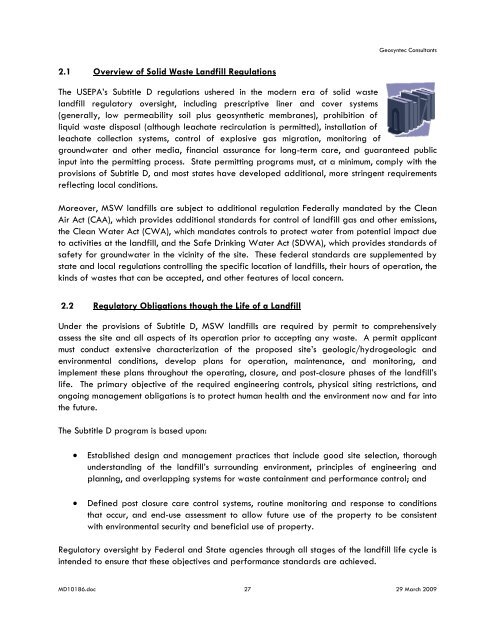AREA A/B ENGINEERING REPORT - Waste Management
AREA A/B ENGINEERING REPORT - Waste Management
AREA A/B ENGINEERING REPORT - Waste Management
Create successful ePaper yourself
Turn your PDF publications into a flip-book with our unique Google optimized e-Paper software.
2.1 Overview of Solid <strong>Waste</strong> Landfill Regulations<br />
Geosyntec Consultants<br />
The USEPA’s Subtitle D regulations ushered in the modern era of solid waste<br />
landfill regulatory oversight, including prescriptive liner and cover systems<br />
(generally, low permeability soil plus geosynthetic membranes), prohibition of<br />
liquid waste disposal (although leachate recirculation is permitted), installation of<br />
leachate collection systems, control of explosive gas migration, monitoring of<br />
groundwater and other media, financial assurance for long-term care, and guaranteed public<br />
input into the permitting process. State permitting programs must, at a minimum, comply with the<br />
provisions of Subtitle D, and most states have developed additional, more stringent requirements<br />
reflecting local conditions.<br />
Moreover, MSW landfills are subject to additional regulation Federally mandated by the Clean<br />
Air Act (CAA), which provides additional standards for control of landfill gas and other emissions,<br />
the Clean Water Act (CWA), which mandates controls to protect water from potential impact due<br />
to activities at the landfill, and the Safe Drinking Water Act (SDWA), which provides standards of<br />
safety for groundwater in the vicinity of the site. These federal standards are supplemented by<br />
state and local regulations controlling the specific location of landfills, their hours of operation, the<br />
kinds of wastes that can be accepted, and other features of local concern.<br />
2.2 Regulatory Obligations though the Life of a Landfill<br />
Under the provisions of Subtitle D, MSW landfills are required by permit to comprehensively<br />
assess the site and all aspects of its operation prior to accepting any waste. A permit applicant<br />
must conduct extensive characterization of the proposed site’s geologic/hydrogeologic and<br />
environmental conditions, develop plans for operation, maintenance, and monitoring, and<br />
implement these plans throughout the operating, closure, and post-closure phases of the landfill’s<br />
life. The primary objective of the required engineering controls, physical siting restrictions, and<br />
ongoing management obligations is to protect human health and the environment now and far into<br />
the future.<br />
The Subtitle D program is based upon:<br />
• Established design and management practices that include good site selection, thorough<br />
understanding of the landfill’s surrounding environment, principles of engineering and<br />
planning, and overlapping systems for waste containment and performance control; and<br />
• Defined post closure care control systems, routine monitoring and response to conditions<br />
that occur, and end-use assessment to allow future use of the property to be consistent<br />
with environmental security and beneficial use of property.<br />
Regulatory oversight by Federal and State agencies through all stages of the landfill life cycle is<br />
intended to ensure that these objectives and performance standards are achieved.<br />
MD10186.doc 27 29 March 2009

















